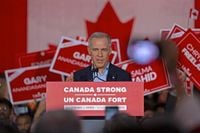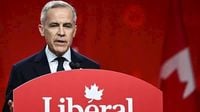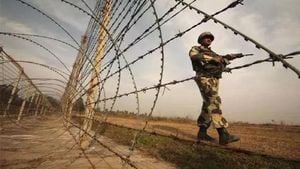In a bold move, Canadian Prime Minister Mark Carney has announced a significant increase in military spending, pledging 30.9 billion Canadian dollars over the next four years. This announcement was made during the launch of the Liberal Party's election program on April 20, 2025, in Toronto, where Carney emphasized the need for Canada to bolster its defenses in response to what he termed "American threats to Canadian sovereignty."
Carney warned that the United States "wants our land, our resources, our waters, and our country," reflecting concerns over U.S. President Donald Trump's previous comments about potentially annexing Canada as the 51st state. "President Trump is trying to undermine us to make Canada an American property, and this will never happen. We need a clear plan to deal with this new reality," Carney stated, underscoring the urgency of the situation.
The Liberal Party's plan aims to meet NATO's defense spending target of 2% of Canada’s GDP by 2030, a goal that Carney intends to achieve two years ahead of schedule. Currently, Canada’s defense spending hovers around 1.37% of its GDP, indicating a substantial shift in military priorities.
A significant portion of the new budget will be directed toward enhancing Canada’s military presence in the northern regions, particularly to counteract what Carney described as "Chinese threats". This focus comes amid concerns that climate change is opening new shipping routes and allowing for the exploitation of Canada’s natural resources.
The plan outlines three main areas for spending: the first will focus on recruiting new members to the Canadian Armed Forces, increasing military salaries, and constructing new housing at military bases. The second part will fund new military equipment, including self-propelled artillery systems and ground-based defense capabilities, which could be used domestically or deployed in Europe. Additionally, the government has been collaborating with Australia to develop radar defense systems for missile warning.
The third area of investment will target advancements in quantum computing and artificial intelligence, fields in which Canada is emerging as a leader. A Liberal Party official noted that the military could leverage AI for autonomous vehicles and intelligence processing.
Carney's plan also emphasizes collaboration with Indigenous communities to develop infrastructure and energy projects in the North, aiming to make the region more appealing for living and working. He has committed to working with European partners on Arctic security, aligning with similar pledges made by his main political rival, Conservative Party leader Pierre Poilievre.
Poilievre has also promised to prioritize defense spending if he wins the upcoming elections scheduled for April 28, 2025. He criticized Carney's spending increase as "wasted" and accused him of creating a financial deficit larger than that left by former Prime Minister Justin Trudeau.
On April 18, 2025, the Liberal Party provided further details on its defense strategy, which includes plans to update the North American Aerospace Defense Command (NORAD) and establish a new permanent military base in Iqaluit, Nunavut, the largest Inuit community in Canada. Another base is set to be rebuilt in Inuvik, approximately 125 miles north of the Arctic Circle, aimed at enabling rapid responses to incursions from Russia and China.
In a recent statement at NATO headquarters, U.S. Secretary of State Marco Rubio called for alliance members to increase their defense spending, suggesting a target of 5% of GDP in the near future. Rubio noted, "If the threats are real, as I believe they are, we must face this threat with a full and realistic commitment to our capabilities."
In response to Rubio's comments, Poilievre remarked that Canada is "by far underfunding its army," suggesting that if a swift resolution to trade disputes could be achieved, he would allocate all additional trade revenues to rebuilding the armed forces.
Carney's election program is designed not only to enhance military capabilities but also to protect Canada's culture and sovereignty from what he described as "Trump’s unfair trade war." He stated, "America’s reckless trade war threatens Canadian jobs and our way of life. In the face of this threat, we have a plan to build a stronger economy in the G7."
The Liberal plan also aims to dismantle trade barriers between Canadian provinces to mitigate the impact of U.S. tariffs and to support the agricultural sector, which has been adversely affected by ongoing trade wars with the U.S. and China. Furthermore, it seeks to foster new trade relationships with Europe and Asia, with aspirations to negotiate agreements with the Southern Common Market (Mercosur) and the Association of Southeast Asian Nations (ASEAN).
While Carney is committed to increasing defense spending, he has also pledged to reduce overall government expenditure, particularly in the federal public service sector, in order to balance the operational budget by 2028. He assured that essential services such as healthcare, pensions, and employment insurance would be protected.
As Canada prepares for the upcoming elections, the political landscape is heating up. With early voting already showing record turnout—approximately one million Canadians cast their ballots on the first day of early voting on April 18—both Carney and Poilievre are gearing up for a fierce contest. The stakes are high, and the outcome could shape not only Canada’s defense strategy but also its international relations and economic future.





